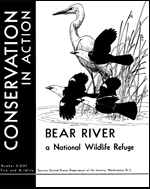United States Fish and Wildlife Service

United States Fish and Wildlife Service: Publications
Date of this Version
2010
Abstract
This study evaluated selenium and atrazine exposure and effects to fish and wildlife at North Platte National Wildlife Refuge (Refuge) in Scotts Bluff County, Nebraska. Atrazine was detected in 2 of 54 water samples and at low concentrations that are not of concern. However, concentrations of selenium and strontium exceeded toxicity guidelines in water, sediment, invertebrates, whole-body fish and wood duck eggs. Concentrations of selenium in water at Refuge sites frequently exceeded a 2 μg/L total recoverable threshold for selenium bioaccumulation and were greatest at Stateline Island (9.7 μg/L) and Little Lake Alice (24 μg/L). In sediments, strontium concentrations were elevated above background (49 mg/kg) at all sites but were greatest at Stateline Island (858 mg/kg). Selenium in sediments was greatest at Stateline Island (mean = 9.6 ± 2.1 mg/kg) and exceeded a 4 mg/kg toxicity guideline at which adverse effects to some fish and wildlife species may occur. Concentrations of selenium in aquatic invertebrates averaged 10 ± 2 mg/kg at Stateline Island and 6 ± 2 mg/kg at Winters Creek Lake and exceeded a 3 - 8 mg/kg dietary benchmark for reproductive impairment in birds. Fish from all sites had tissue selenium concentrations above a 4 mg/kg effects threshold for protecting fish health and reproduction. Twenty-nine of 40 fish sampled also exceeded a 2 mg/kg wet weight human health advisory for limited consumption. Concentrations of selenium in wood duck eggs at Lake Alice and Lake Minatare averaged 5.9 ± 0.6 and 6.4 ± 0.3 mg/kg, respectively, and 20 of 42 eggs exceeded a 6 mg/kg toxicity threshold for reduced hatchability. An aquatic hazard assessment of selenium for each Refuge subunit was derived using a protocol that considers selenium concentrations in water, sediments, invertebrates, fish and bird eggs. This assessment indicates high risk to Refuge biota from selenium exposure at Winters Creek Lake and Stateline Island and moderate risk at Lake Alice and Lake Minatare. Recommendations to reduce selenium exposure include management actions aimed at increasing selenium volatilization and phytoremediation.


Comments
Published by the U.S. Fish and Wildlife Service, 1-72, (2010)